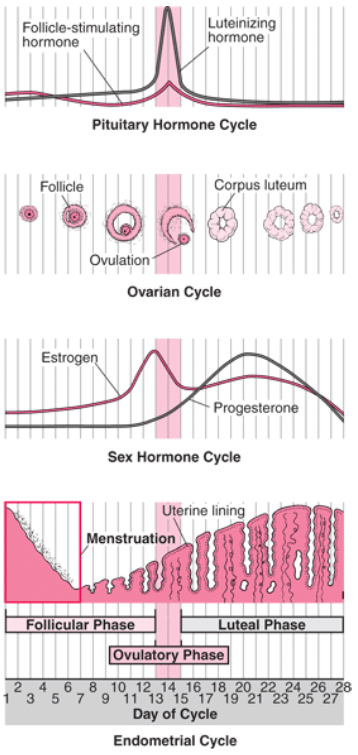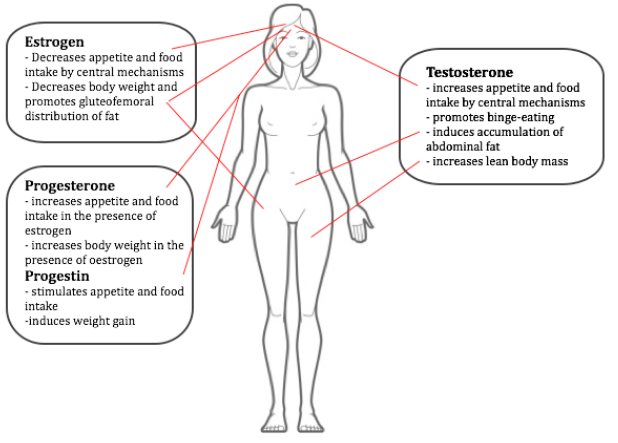The human body is a complicated and complex system that operates on a deep cellular level.
It is these cells that also form the reproductive system in both males and females.
This process starts in the brain, where the hypothalamus begins the interactions between the genital organs, pituitary gland and adrenal glands to regulate the female reproductive system.
Throughout this process we see a significant release of hormones, the chemical messengers that control and coordinate certain activities in the body.
The hypothalamus produces gonadotrophin-releasing hormone, while stimulating the pituitary gland to produce LH and FSH hormones. These hormones are responsible for stimulating the male and female sex hormones.
For males this tends to be a smooth and consistent cycle, yet for females, the menstrual cycle is not so controllable or predictable.
This article will help you understand the female menstrual cycle, including the effects of nutrition, ageing and environmental factors. The female reproductive system is a complicated and detailed topic.
By having a good knowledge of it you will be able to better achieve a healthy menstrual cycle.
Before digging in, as a valued reader of the blog, I’d like to extend you an invitation to our upcoming and totally FREE online training workshop:
‘The Proven Nutrition Strategies of Elite Trainers’.
This workshop is for you if you want to finally learn the best nutrition protocols and evidenced-based strategies to help your clients achieve life-changing results.
This workshop is our most complete training on how to make nutrition coaching easy and profitable.
All you need to do to attend is click here to register your free spot.

Puberty In Girls
The puberty phase for both males and females is a time when physical changes occur, bringing changes in the levels of the hormones released by the pituitary gland, stimulating the production of sex hormones.
For females, this signals the increase of oestrogen and progesterone hormones, thus maturing the female body as a result.
This physical change typically occurs around the age of 8-13 with the menstrual cycle not starting for another 2-3 years after.
Nutrition can have a significant impact on supporting this process as, on average, puberty now begins 3 years earlier than it did 100 years ago.
It is believed that improved nutrition and healthcare has been a driving factor in this.
It is also debated that the high levels of chemicals and toxins that contain oestrogen are responsible for earlier puberty ages in females, but little research is available to confirm this.
It is also common for overweight girls to start puberty earlier, while underweight and malnourished girls can see delayed changes. Genetics can also play a role here too.
This highlights the importance of good nutrition in the young, to ensure they reach sexual maturity in the healthiest manner possible.
Another important point to note is that during puberty, the girls body shape changes and it’s not uncommon for body fat percentage to increase, typically accumulating in the hips and thighs.
This could be of relevance if you are working with young athletes.
Menstrual Cycle
Menstruation is approximately a monthly cycle that occurs throughout a women’s reproductive life. It starts during puberty (at menarche), ceases during pregnancy and stops permanently at menopause.
Menstruation is shredding of the lining of the uterus followed by bleeding. The menstrual cycle begins with first day of bleeding and is concluded before the next menstrual period. This cycle typically lasts from about 25-36 days and for many females these cycles are irregular.
The menstrual cycle is regulated by hormones. These stimulate the ovaries to produce oestrogen which encourages the eggs to mature and starts to thicken the lining of the uterus so that it’s ready to support a pregnancy, should fertilization occur.
This process can be broken down into 3 key phases:
1. Follicular Phase
This phase is considered the start of the menstrual cycle, as bleeding starts and the development of follicles in the ovaries occurs. Bleeding occurs from breakdown of the uterus as oestrogen and progesterone levels are low and no egg has been fertilized.
Also, at this time, the pituitary gland increases its production of follicle- stimulating hormone. As the name implies, this stimulates the growth of up to 30 follicles, each containing an egg. Only one of these follicles grow and by doing so begins to produce oestrogen, stimulating the luteinizing hormone (LH) even more.
This phase typically lasts 12-14 days, but can vary in length. This phase ends when a spike in LH dramatically occurs.
2. Ovulatory Phase
With a spike in LH, this kick starts the ovulatory phase in which the dominant follicle ruptures to release the egg. At this same time, we see an increase in the follicle-stimulating hormone.
This phase typically lasts just 16 to 32 hours and ends when the egg is released. The egg can be fertilized for only up to about 12 hours after its release.
3. Luteal Phase
This final phase occurs after ovulation and lasts about 14 days. At this point, the ruptured follicle closes after releasing the egg, to form a structure called a corpus luteal.
This also triggers increased levels of progesterone, which prepares the uterus in case the egg was fertilized. This preparation phase sees the thickening of the endometrium containing fluids and nutrients to nourish a fertile egg.
If the egg is not fertilized, the corpus luteal breaks down after 14 days, levels of oestrogen and progesterone decrease, and a new menstrual cycle begins.

Amenorrhea
Amenorrhea is the absence of menstruation in a women of reproductive age, or one or more missed menstrual periods.
There are 4 different types of amenorrhea:
Primary Amenorrhea
The lack of a menstrual cycle at puberty and as previously mentioned, workout nutrition/nutrition and body weight can have a significant impact on this.
Dietary Amenorrhea
Studies indicate that dietary intake, or more specifically low calorie intake leading to low body fat levels can disturb the healthy menstrual cycle.
Hypothalamic Amenorrhea
A reduced output of follicle-stimulating hormone (FSH) from the pituitary gland can cause infrequent or complete absence of menses. This reduced output has been linked to excessive stress effects or levels, whether environmental, lifestyle or thyroid dysfunction.
Anovulation
With this type the ovaries function but no ovulation occurs. Therefore the menstrual cycle takes place, but no egg is produced. This can make this type of amenorrhea difficult to discover and resolve.
Again, high stress loads or lower caloric intake can be the case. Physical stress such as over training along with low calorie intake is a common cause in active females.
If this appears evident in a client, then proper nutritional re-introduction and rest from over training can reset the menstrual cycle often within a few months.
Menopause
Menopause is a perfectly natural part of a woman’s life cycle, and signals the cessation of menses, the end of the menstrual cycle. Many changes occur rapidly to the female reproductive system and this process should not be interrupted.
Premenopause is when a woman’s hormone balance can begin to change at an earlier age than expected. This hormone balance can be connected to stress levels, nutrition, and daily environmental factors.
When undergoing these changes women can experience weight gain, water retention and mood swings, but this is highly individual from one female to the next.
There may be symptoms of oestrogen dominance caused mainly by lack of ovulation and thereby lack of progesterone.
Birth Control
Many women will take birth control pills throughout their reproductive years, and while they are effective at stopping pregnancy, they can have some unwanted side effects.
To date there have been a large number of studies completed on birth control pills, using thousands of females, which have concluded they are safe to use. Some females do experience negative side effects from using certain types of pill.
Scientific studies reported that women taking oral contraception have lower levels of vitamin B6, vitamin B12, folic acid and tyrosine. Low levels of these nutrients have been linked to depression.
Hormonal birth control pills work by adding additional progesterone to the menstrual cycle. The body cannot ovulate if there are high levels of progesterone in the blood stream.
Another common concern for women is the potential for weigh gain while taking the pill. When birth control pills were first introduced, they contained very high levels of hormones, including progesterone, which could have been linked to weigh gain.
Nowadays, hormones are used in much smaller doses, and research indicates that weigh gain is not a direct link from using the pill. However, not all hormones are created equal and could affect a female’s weigh via 2 main ways:
1. Increased appetite - pills high in progesterone (or no oestrogen at all) may increase appetite in the short term. The same can occur for pills high in ‘androgenic’ progesterone.
2. Water retention – pills higher in oestrogen levels, or just a high quantity in general can cause water retention.

Nutrition for a Healthy Menstrual Cycle
Throughout the menstruation cycle, due to the changing hormonal patterns, women’s nutrition and training recommendations can change.
During the follicular phase, cravings can be higher, as the body burns through glucose for energy to support the processes. But, with higher oestrogen levels, this also means improved fat burning, less fat storage and a greater ability to use carbohydrates.
It is therefore possible to increase carbohydrates/calories during this time and may be a beneficial thing to do for females undertaking activity and/or a low calorie diet.
During the luteal phase, cravings usually reduce, and the body no longer requires the extra energy. The body is now more likely to store body fat than it was previously. At this point, it’s important to then reduce carb/calorie levels again and get back on track with the typical dietary schedule.
Become an elite-level nutrition coach
My team and I have just finished up creating a brand new online training workshop called 'The Proven Nutrition Strategies of Elite Trainers.'
Best part? It costs you nothing. This is your official invite - all you need to do to attend is click here to register.
This free nutrition course is for you if you want to finally learn the best nutrition protocols and evidenced-based strategies to help your clients achieve life-changing results.
Join me and I’ll walk you through the exact steps you need to take in order to get incredible client results, boost your confidence and build your business with proven nutrition coaching strategies.

